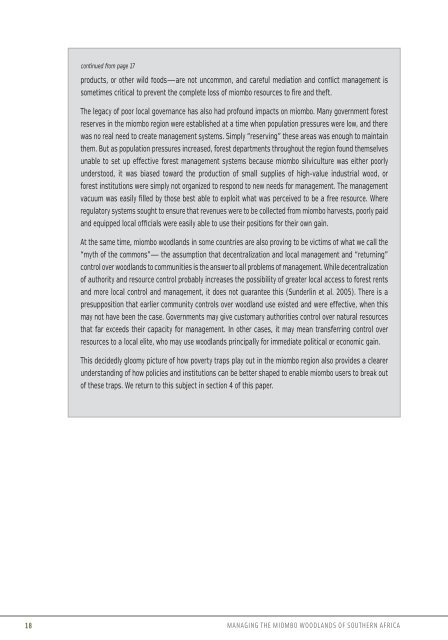Managing the Miombo Woodlands of Southern Africa - PROFOR
Managing the Miombo Woodlands of Southern Africa - PROFOR
Managing the Miombo Woodlands of Southern Africa - PROFOR
Create successful ePaper yourself
Turn your PDF publications into a flip-book with our unique Google optimized e-Paper software.
continued from page 17<br />
products, or o<strong>the</strong>r wild foods—are not uncommon, and careful mediation and conflict management is<br />
sometimes critical to prevent <strong>the</strong> complete loss <strong>of</strong> miombo resources to fire and <strong>the</strong>ft.<br />
The legacy <strong>of</strong> poor local governance has also had pr<strong>of</strong>ound impacts on miombo. Many government forest<br />
reserves in <strong>the</strong> miombo region were established at a time when population pressures were low, and <strong>the</strong>re<br />
was no real need to create management systems. Simply “reserving” <strong>the</strong>se areas was enough to maintain<br />
<strong>the</strong>m. But as population pressures increased, forest departments throughout <strong>the</strong> region found <strong>the</strong>mselves<br />
unable to set up effective forest management systems because miombo silviculture was ei<strong>the</strong>r poorly<br />
understood, it was biased toward <strong>the</strong> production <strong>of</strong> small supplies <strong>of</strong> high-value industrial wood, or<br />
forest institutions were simply not organized to respond to new needs for management. The management<br />
vacuum was easily filled by those best able to exploit what was perceived to be a free resource. Where<br />
regulatory systems sought to ensure that revenues were to be collected from miombo harvests, poorly paid<br />
and equipped local <strong>of</strong>fi cials were easily able to use <strong>the</strong>ir positions for <strong>the</strong>ir own gain.<br />
At <strong>the</strong> same time, miombo woodlands in some countries are also proving to be victims <strong>of</strong> what we call <strong>the</strong><br />
“myth <strong>of</strong> <strong>the</strong> commons”— <strong>the</strong> assumption that decentralization and local management and “returning”<br />
control over woodlands to communities is <strong>the</strong> answer to all problems <strong>of</strong> management. While decentralization<br />
<strong>of</strong> authority and resource control probably increases <strong>the</strong> possibility <strong>of</strong> greater local access to forest rents<br />
and more local control and management, it does not guarantee this (Sunderlin et al. 2005). There is a<br />
presupposition that earlier community controls over woodland use existed and were effective, when this<br />
may not have been <strong>the</strong> case. Governments may give customary authorities control over natural resources<br />
that far exceeds <strong>the</strong>ir capacity for management. In o<strong>the</strong>r cases, it may mean transferring control over<br />
resources to a local elite, who may use woodlands principally for immediate political or economic gain.<br />
This decidedly gloomy picture <strong>of</strong> how poverty traps play out in <strong>the</strong> miombo region also provides a clearer<br />
understanding <strong>of</strong> how policies and institutions can be better shaped to enable miombo users to break out<br />
<strong>of</strong> <strong>the</strong>se traps. We return to this subject in section 4 <strong>of</strong> this paper.<br />
18 MANAGING THE MIOMBO WOODLANDS OF SOUTHERN AFRICA

















